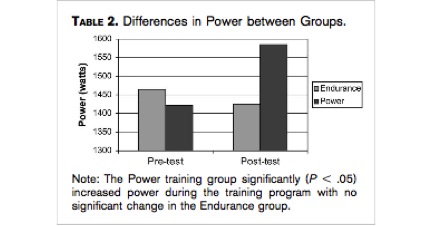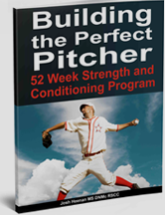Why Your Conditioning is Hurting Your Performance on the Mound!
By now, readers of this blog are familiar with the concept of the “well rounded athlete”—the athlete who focuses on the fundamentals of movement and conditioning in order to master the finer points of his sport. While I believe that all baseball players should embrace this philosophy, I urge pitchers to exercise particular caution in applying it. This is especially true with regard to distance running and pole running, two long-time staples in the pitching community. As I explain in the following paragraphs, these conditioning methods may harm a pitcher’s on-field performance more than they enhance it.
Common Misuses of Conditioning
The first misconception about distance and pole running is that they help to remove excess lactate from the blood after a pitching outing. This belief embodies a basic misunderstanding of the physiology of pitching. Pitching is a maxium effort burst movement that is repeated dozens of times over the course of a game. The burst motion of pitching relies on the phosphogen or ATP-CP system, which is regarded as a lactic anaerobic energy system because it neither uses oxygen nor produces lactic acid if oxygen is unavailable. In laymen’s terms this means that, contrary to popular belief, pitching does not increase blood lactate levels significantly. Therefore, “flush” runs designed to lower blood lactate levels merely expose pitchers to a decrease in power and increased risk of injury without bestowing any measurable benefit.1
Distance and pole running present other problems as well: a lack of neural adaptation (high powered nervous system output); limited or diminished strength gains; and an underdeveloped range of motion in portions of the lower body that are essential to the pitching motion. Holloszy and Booth produced the following paragraph while studying the biochemical adaptations to endurance exercise in muscle.
“The nature of the exercise stimulus determines the type of adaptation. One type of adaptation involves hypertrophy of the muscle cells with an increase in strength; it is exemplified in its most extreme form by the muscles of weight lifters and bodybuilders. The second type of adaptation involves an increase in the capacity of muscle for aerobic metabolism with an increase in endurance and is found in its most highly developed form in the muscles of competitive middle- and long distant runners, long distant cross country skiers, bicyclists, and swimmers. Although many types of physical activity can bring about varying degrees of both types of adaptation in the same muscle, it does appear that these adaptations can occur quite independently of each other in their most extreme forms. For example, the hypertrophied muscles of weight lifters do not appear to have increased respiratory capacity, whereas the muscles of rodents trained by prolong daily running, which have large increase in respiratory capacity, are not hypertrophied and show NO INCREASE IN STRENGTH”2
As I have discussed elsewhere, bodyweight is directly correlated to ball velocity. Distance running reduces an athlete’s fast twitch muscle fiber count and muscle mass, which leads to diminished overall body mass and ultimately robs a pitcher of crucial miles per hour on his pitches. However, there is good news even for pitchers who have unwittingly sacrificed body mass and velocity by doubling as distance runners. By using creatine as a dietary supplement, a pitcher can increase body mass both quickly and safely, and will likely reap the benefits in the form of increased ball velocity. I discuss this topic at length in my article “Why All Baseball Players Should Be Using Creatine.”
Further proof that pitchers should avoid distance running is offered in a tremendous article titled “Noncompatibility of Power and Endurance Training Among College Baseball Players.” This study split 16 Division I collegiate pitchers on the same team into 2 groups, both of which were tested before and after th season. The sprint group performed repeated maximal sprints ranging from 15 to 60 meters with 10 to 60 seconds rest between each sprint. Workouts were performed 3 days per week and consisted of 10–30 sprints. The second group (8 Pitchers) performed moderate- to high-intensity aerobic exercise (jogging or cycling) 3–4 days per week for 20–60 minutes per day (mainly poles). Over the course of the season, the sprint group increased power by ~20% while the endurance group decreased power by ~ 3%. That’s dramatic.3
In short, pitchers should think long and hard before incorporating distance and/or pole running into their training routines. Basic physiology suggests (and the research confirms) that these endurance-based practices jeopardize a pitcher’s power, muscle mass, and skill-specific endurance. Any pitcher intent on succeeding at the highest levels of the game should focus on building and maintaining muscle mass and fine tuning mechanics to optimize the power transfer between his wind-up and delivery. Ball velocity is, and always will be, the factor that separates the wheat from chaff.
Optimal Conditioning for Pitchers
Here are three options I use for conditioning for pitchers (all baseball players for that matter). Be sure to fit your workload and rest frequencies to the aerobic and muscular systems that you are working on.
- Sled Pushes
Sets of 10-40 yards. You can adjust loading parameters to meet your goals with regard to power, speed, and strength.Shout to @josh_heenan giving me that 700lb sled push for breakfast.
— John Michael Murphy (@MurphsLaws) November 11, 2013
- Flat Ground Sprints
Sets of 10-40 yards. You can play with the number of sets to fit your goal of repeated power. - Hill Sprints
Sets of 10-20 yards is sufficient. You can play with the number of sets to fit your goal of repeated power. Obviously the steeper the hill, the more you will hate life!
Conclusion
Just because a practice has become tradition does not mean that it is the best, or even a good way, to enhance on-field performance. Further research and anecdotal evidence will undoubtedly reveal even better ways than the ones I offer above to optimize a pitcher’s output. However, the next time a coach tells you to run poles or run a few miles, politely share this article with him and ask their opinion. I welcome any and all feedback, and I sincerely hope that this post is merely the start of a much larger conversation.
Works Cited
1. Potteiger JA, Blessing DL, Wilson GD. The physiological responses to a single game of baseball pitching. J Strength Cond Res. 1992;6(1):11–18.
2. Holloszy JO, Booth FW. Biochemical adaptations to endurance exercise in muscle. Annu Rev Physiol. 1976;38:273–291. doi:10.1146/annurev.ph.38.030176.001421.
3. Rhea MR, Oliverson JR, Marshall G, Peterson MD, Kenn JG, Ayllón FN. Noncompatibility of power and endurance training among college baseball players. J Strength Cond Res Natl Strength Cond Assoc. 2008;22(1):230–234. doi:10.1519/JSC.0b013e31815fa038.












Dr. Josh Heenan | Why Your Recruiting Sucks 6:59 pm on October 5, 2014
[…] that jumping into a program that conditions their athletes like cross country runner is going to DECREASE muscle mass, strength, size, and power while INCREASE risk of injury. A terrible decision if you wish to play ball after […]
Stanley Beekman 4:50 am on October 6, 2015
Hi Josh, Great article. I started Olympic lifting (which is a pure fast twitch fiber sport), at 37 after years of running marathons. My vertical jump was less 6″ when I started and my first squat of 95lbs made me so sore, the next day I couldn’t sit down because of the pain on the way down. At age 50, my vertical jump was 24″. I remember I hit a plateau and I couldn’t increase. I used creatine, and it increased my weights by 10%. The older you are the better it works, as you don’t make it as well as you age (like everything else). Also I found out that not everyone in the gym made gains. It could have been the individual, but also some of the creatine at the time I was lifting was not real creatine. It had a slightly different taste and I didn’t make any gains. BTW at age 47 weighing 167 pounds I worked up to a 340lb squat, a 380lb dead lift, and a 259lb clean.
Josh Heenan 9:22 pm on October 20, 2015
Thanks for the kind words Stanley. And great lifts!
Terry clark 3:18 am on October 28, 2015
I have been in baseball at the pro level for 37 years can you explain to me how long running once or twice a week does not help you. Everybody is caught up on the velocity kick but if you look at the number of complete games in the last ten years it is a joke compared to the 70s and early 80s. I know the game has changed but people still love the pitcher that stays out there deep in the game and if you throw 200 innings a year you will make a lot of money and have a job for a long time. I don’t believe that sprints will do that for you.
Josh Heenan 11:54 pm on March 29, 2016
Terry,
Based on the research cited in this article, it’s cut and dry that distance running will zap power. The transfer of motion from distance running compared to sprints is not the same either.
I understand your point on complete games, but that is an anecdotal point, not causation. Check out this great article by Nick Doran http://redlegnation.com/2015/02/19/running-down-the-velocity-upswing/
The PITCHfx data presented here is awesome. Unfortunately, we don’t have data prior to 2008. What we can see is highly correlated trends to higher pitching velocities each year, a drop in ERA, and increases in Ks. That is why people are so hung up on velocity, because it IS harder to hit (based on research).
Also, look at the average height and weight of pitchers from 1955-2014— consistently taller and heavier. Research has pinned down that there is a DIRECT correlation between bodyweight and velocity (Werner SL, Suri M, Guido JA Jr, Meister K, Jones DG. Relationships between ball velocity and throwing mechanics in collegiate baseball pitchers. J Shoulder Elbow Surg. 2008;17(6):905–908). With the addition evolution of strength training and sports science, we can get athletes bigger and stronger than ever. With those facts combined, we will have pitchers that throw harder and push the limits of their bone, muscular, and tendon systems. At some point, these athletes break down. Basic physics would agree that a guy who touches 100MPH is exponentially more likely to get injured than a guy touching 85MPH.
We have may tricks in our tool box to help athletes throw faster in a matter of minutes, but we often hold back as we want to make sure their whole body can handle the transfer of force and not end up on the disabled list because their elbow or shoulder can’t handle that amount of force. It takes thoughtful training to accomplish this.
Steve 12:47 am on March 30, 2016
Hi Josh, regarding your statement “As I have discussed elsewhere, bodyweight is directly correlated to ball velocity.”
Can you give us a correlation between height, weight, and max velocity? I have read an article on the internet that suggested to reach max velocity at 6’0″, a pitcher should weigh 190 lbs. For every inch taller than 6’0″, one would add 10lbs to the 190lb frame. For every inch smaller than 6’0″, one would subtract 10 pounds from the 190 lb frame.
What are your thoughts on those numbers.
Thanks,
Steve
Josh Heenan 7:12 pm on March 30, 2016
Steve,
Here is a link to my 90 MPH formula. This should help you with the weight question.
http://joshheenan.com/add-muscle-mass-get-recruited-and-drafted/
Best,